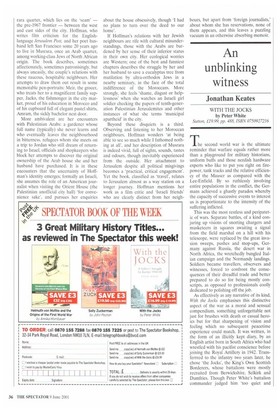Local colour and confusion
Naomi Shepherd
HOUSE OF WINDOWS by Adina Hoffman
Arcadia, £11.99, pp. 217, 158N 1900850621 Adina Hoffman's corner of Jerusalem is one unknown to tourists and to most Israelis save as an area of social discontent and occasional violence. This is the Mus
rara quarter, which lies on the 'seam' — the pre-1967 frontier — between the west and east sides of the city. Hoffman, who writes film criticism for the Englishlanguage Jerusalem Post, and her poet husband left San Francisco some 20 years ago to live in Musrara, once an Arab quarter, among working-class Jews of North African origin. The book describes, sometimes affectionately, sometimes patronisingly, but always uneasily, the couple's relations with these raucous, hospitable neighbours. Her attempts to draw them out result in some memorable pen-portraits: Meir, the grocer, who treats her to a magnificent family supper, Jacko, the fishmonger in the city market, proud of his education in Morocco and of his cupboard full of elegant pastel shirts, Arnram, the sickly bachelor next door.
More ambivalent are her encounters with Palestinian Arabs: a gardener whose full name (typically) she never learns and who eventually leaves the neighbourhood in bitterness, refugees whom she meets on a trip to Jordan who still dream of returning to Israel, officials and shopkeepers who block her attempts to discover the original ownership of the Arab house she and her husband have purchased. It is in these encounters that the uncertainty of Hoffman's identity emerges; formally an Israeli, she assumes the role of an American journalist when visiting the Orient House (the Palestinian unofficial city hall) 'for convenience sake', and pursues her enquiries
about the house obsessively, though 'I had no plans to turn over the deed to our home'.
If Hoffman's relations with her Jewish neighbours are rife with cultural misunderstandings, those with the Arabs are burdened by her sense of their inferior status in their own city. Her ecological worries are Western; one of the best and funniest chapters describes the struggle by her and her husband to save a eucalyptus tree from mutilation by ultra-orthodox Jews in a nearby seminary, in the face of the total indifference of the Moroccans. More strongly, she feels 'shame, disgust or helplessness' when she watches an Israeli girl soldier checking the papers of tenth-generation Palestinian Jerusalemites and other instances of what she terms 'municipal apartheid' in the city.
Beyond these disquiets is a third. Observing and listening to her Moroccan neighbours, Hoffman wonders 'at being able to see so much while I fathomed nothing at all', and her description of Musrara is indeed vivid, full of sights, sounds, tastes and odours, though inevitably experienced from the outside. Her attachment to Jerusalem despite all political misgivings becomes a 'practical, critical engagement'. Yet the book, classified as 'travel', relates to Jerusalem almost as a way station on a longer journey. Hoffman mentions her work as a film critic and 'Israeli friends' who are clearly distinct from her neigh hours, but apart from 'foreign journalists,' about whom she has reservations, none of them appears, and this leaves a puzzling vacuum in an otherwise absorbing memoir.



































































 Previous page
Previous page